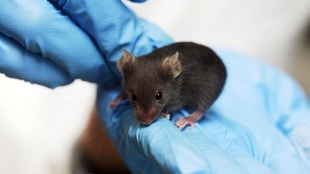A consortium of 17 laboratories worldwide has presented results contradicting a highly cited study that described a technique to create conditional knockout mice using CRISPR. The preprint, published on bioRxiv on September 1, shows a much lower efficiency rate for the technique compared to the original report.
The results of the new study indicate the limitations of the original study, whose success appears to be relegated to deleting a specific gene within a hybrid mouse strain. The lead author of the first report, cited nearly 1,000 times by Google Scholar’s count, stands by the strength of his method.
Before the original study, published in 2013 by geneticist Rudolf Jaenisch at the Whitehead Institute of Biomedical Research and colleagues, embryonic stem cells were used to prepare conditional knockout mice—animals with a gene engineered to be turned off on command that are missing a gene—a process that could take years and had only a 1 percent efficacy rate. The CRISPR technique was presented as one-stop-shop to obtaining conditional knockout mice with a 16 percent success rate. By injecting zygotes with the CRISPR machinery, Jaenisch’s team successfully sandwiched the to-be-deleted gene between two LoxP sites (a step called floxing) that allow the gene to be conditionally regulated.
“The original Jaenisch paper was a landmark,” says geneticist John Schimenti, director of Cornell University’s Stem Cell and Transgenic Core Facility, who was not involved in either study. “It certainly demonstrated that you can get a high efficiency and high efficiency mutagenesis at specific loci.”
Conditional knockout mice are extremely important in biomedical research as they let scientists delete essential genes in specific tissues in the organism and at particular times during development. While the Jaenisch method was promising, research groups that have tried to generate mice using the technique have not been as successful.
“Everybody who’s tried to make floxed alleles by the method they originally proposed is generally met with failure,” says Schimenti, who has observed the “same exact issues” in Cornell’s transgenic facility as those noted in the preprint.
The Jaenisch method often results in off-target mutations, deletions, or a failure to insert both LoxP sites in the correct orientation, notes Schimenti. “This is generally recognized in the community, it’s been very difficult to recapitulate anything close to the numbers that Jaenisch’s group reported,” he says.
Talks between a close-knit research community at conferences and elsewhere about the challenges other labs were having with the technique led Gaetan Burgio, who runs the transgenesis facility at the Australian National University, and his colleagues to try and determine what was going wrong.
To begin with, three groups replicated the original experiment targeting the same gene in a different strain of mice and had zero success. Next, 17 labs, including the original three, independently repeated the experiment on a total of 56 genes and two intergenic regions in the mouse genome across five different strains of mice. The combined dataset from all the labs included 17,887 microinjected or electroporated mouse zygotes and a resultant 1,718 live mice, of which only 15 possessed both of the inserted LoxP sites needed for conditional control. Across all the mice that were tested, off-target deletions or mutations were observed in lieu of the correct insertion of the LoxP sites.
Compared to the original study’s 16 percent efficiency rate of obtaining conditional knockout alleles in mice, Burgio and others had a success rate of merely 0.87 percent. “The success rate of the method . . . is equivalent to the classical methods with embryonic stem cells,” says Burgio.
The replication team aimed to figure out the possible factors responsible for successful conditional knockout mice and found that the simultaneous insertion of two LoxP sites was critical for the success of the technique.
Jaenisch considers the difference between the mouse strains used in the two studies to be a sticking point and an underlying reason for the high variation between the two studies. “I have to discount these data as being serious,” says Jaenisch, who questions the quality of the recent study.
Schimenti agrees that the genetic background should have been taken into consideration when replicating the original study. “I think it’s kind of a flaw in the bioRxiv study—if they were testing the Jaenisch results, they should have used the exact same types of animals.” However, both Burgio and Schimenti raise the point that the strain of mice used in the Jaenisch paper is uncommon compared to the mice used in the new study.
Schimenti also suggests the possibility that the original 16 percent success rate may have been representative of the single locus in the specific strain of mice used in that study. “I think it’s clear that this is a very problematic technique,” says Schimenti. “There needs to be a workaround.”







